-
vabrou

- Posts: 104
- Joined: Mon May 23, 2022 11:22 am
Re: Sphingid females and pheromones
by vabrou » Thu May 30, 2024 8:57 pm
You mention, I assume the 2007 publication. That subject is not the purpose of that publication, and such a treatment deserves a targeted discussion of using freshly emerged female moths to attract male moths. My personal experience spans the 1960's to 2024. I have used females to attract lots of saturnids, size-wise Anisotas to Attacus. The first problem in attempting to do this is your understanding of methods and your approach to this subject in order to be successful. It would be helpful to identify the naturally occurring wild brood(s) of the particular species where you plan on performing these activities. A particular species is not out and about anytime during the year. In fact, your chances are more limited to around 10 days for each annual brood of a particular species. Determining this for me here in my state of Louisiana was easy because I ran automatic capture light traps at this point for 55 years, 24 hours daily for 365-366 days every year, and documenting numbers of captures each day of the year. Doubtfully you are ready to tackle this massive endeavor. But you could do this on a smaller scale of one or two years. Here my wife and I ended up with around 500 automatic capture insect traps of all types (traps that do not require human presence).
Sure, you could just take your chances without any such information. We didn't have any such information in the mid 60s when I began collecting for any N.A. species. But in 1969 we began with one automatic-capture light trap and each year added another, our target back then to discover all the species of sphingidae occurring in my state. That sphingidae study ended 30 years later when we stopped counting hawkmoths. But, we documented 30 years of actual sphingid phenology data for the first time in N.A. But we also were able to document the same data for thousands of other species found in our hundreds of trap all along.
Being in NW US, you may not be familiar with the saturnid species Callosamia, but attached is a freely accessible link I published after nearly 50 years of collecting Callosamia in Louisiana. Prior to 50 years ago only 2 species of Callosamia were recognized in N.A.. Since then C. securifera was resurrected and elevated to species status. My publication linked here illustrates dates of capture for all three species in Louisiana. If you look at fig. 4 and fig. 5; what do you think the chances you would find adult C. angulifera and A. securifera if you looked for them during the third week of May? Actually the bulk of each brood population occurs (+/- 5 days of each red star) where you see red stars on the phenograms. This type of analysis has never been done before on this genus, and my publication is the first actual evidence that both of these species have 4 annual broods in the SE U.S. What I am getting at is that you could look for adult C. securifera the entire month of May and your success would be minimal to none at all.
Regarding semiochemicals for the genus Smerinthus, you probably would have to special order such things. The only persons I know who have been successful developing lures for sphingidae are some independent researchers in Japan.
Now attempting to attract adult males using females can be troublesome. First, do you know when males of your target species actually fly in to females? E.g. just because females are in a calling posture with protruding abdomens, that has nothing to do with when males fly to these females. E.g. here at my home females of C. securifera call round the clock, but precisely at daybreak, the sky fills with 50-100+ male securifera attempting to mate with the females. see attached you-tube video. And these females kept seperated from the incoming males continue nonstop to call until 1600 hrs to 1800 hours. Interestingly around 1600 hours, C. promethea also begins flying into the calling C. securifera females. This would not happen naturally in the wild as C. securifera would have mated 9-10 hours earlier in the day and there would naturally not be securifera females calling in mid-late afternoon. Others have documented C. angulifera being attracted to C. promethea for probably the same reasons I stated for securifera and promethea.
Another species S. cecropia which females may call for half a day, but precisely at 0300 hours, males in huge numbers descend upon the calling females as if by majic. Most commonly encountered problems are caused by using reared materials in the wild, as reared specimens are almost always never synchronized with the natural phenology of the wild specimens.
One thing you may need to do in attempting to call males to females is these activities require locations where the air can freely flow over the females. I found it necessary to build a large screened cage 4' x 4' x 4' to allow females inside to attract males on the outside. This worked well for many years. Here is a free access 1-minute you tube video of my screened cage in my back yard with 40 or so males of C. securifera being attracted to 3 females newly hatched in mid-day sunlight. I will end by saying "If it was easy, everybody would be doing it".
That publication you mention has about 5-10 errors on every page, cover to cover. I reviewed the first two versions of the manuscripts of this pub. for the author. Sent them back with more red ink than existing black ink. Just looked at one of them a few minutes ago, dated 8-06-2004, three years before publication. After that the author stopped talking with me, except when he wanted something from me. I have learned the hard way not to trust him. I allowed him to visit my home on three occasions, never again.
BTW, I am right now publishing a new species description, one of two new species of sphingidae we discovered right here at our home location about 40 years ago.
free access link: https://independent.academia.edu/VernonAntoineBrouJr
-
adamcotton

- Global Moderators

- Posts: 790
- Joined: Tue Mar 22, 2022 12:24 pm
Re: Where to buy: Bioquip folding net "National Park Special"
by adamcotton » Thu May 30, 2024 6:24 pm
-
adamcotton

- Global Moderators

- Posts: 790
- Joined: Tue Mar 22, 2022 12:24 pm
Re: Buying specimens in bulk for an entomology workshop
by adamcotton » Thu May 30, 2024 6:19 pm
I believe that if you PM nitinra he will be able to reply to you.
Adam.
-
Chuck

- Premium Member - 2024

- Posts: 963
- Joined: Mon May 23, 2022 2:30 pm
Re: Buying specimens in bulk for an entomology workshop
by Chuck » Thu May 30, 2024 6:12 pm
I do need a shipping address. I'm not sure why you can't PM, perhaps one needs a certain number of posts first?
-
papiliotheona

- Posts: 22
- Joined: Wed Oct 04, 2023 11:27 pm
Re: Where to buy: Bioquip folding net "National Park Special"
by papiliotheona » Thu May 30, 2024 5:58 pm
Can you please give the link for this?wollastoni wrote: ↑Thu Jan 25, 2024 10:54 am As long as entomological authorities remain "silent" on that topic, the future of our hobby is indeed at risk. Museum authorities of the world should launch a "give kids a net" campaign.
+ they need to defend the insect trade as Wang, Pierce, Lohman & al did in July 2023 :
"The prodigious reproductive capacity of r-selected insects means that collecting or ranching butterflies from the wild is sustainable if natural habitats are preserved (Bayliss-Smith, 2006; Matiku et al., 2013; Gordon and Ayiemba, 2003; Slone et al., 1997). Sustainable economic profitability might be the most parsimonious explanation for why most traded butterflies are wild-caught. However, this should be examined with an ecosystem service cost-effectiveness analysis. Selling wildlife to preserve wildlife might seem counter-intuitive, but careful analyses that consider local stakeholders in conservation strategies have arrived at similar conclusions involving vertebrates (Di Minin et al., 2016). Unlike their 19th century counterparts, modern collectors for the butterfly trade are stakeholders who depend on pristine habitats for their livelihood, and therefore have a vested interest in habitat conservation. We suggest that the scale and extent of global butterfly trade is best seen as a practice of sustainable, targeted resource extraction that has considerable potential in promoting the conservation of insect habitats."
-
Chuck

- Premium Member - 2024

- Posts: 963
- Joined: Mon May 23, 2022 2:30 pm
Re: Tiger Swallowtails of NY: Finger Lakes, Part II
by Chuck » Wed May 29, 2024 7:03 pm
For my life, I've been a lumper, not a splitter. As you very well know from your own work & collaboration, we now know that some splitting is very appropriate. In the case of the eastern Tiger Swallowtails, I can't say I agree with my traditional views- the Mid Summer Tiger (MST) is closer to canadensis, but clearly it most certainly is NOT. So what to do?
In the case of MST, it's not a simple hybrid, it's a recombinant hybrid that while still hybridizing at the edges of the range has a generally stable, self-sustaining population. It's not islanded totally by geography or time, but in many respects it is, effectively, islanded with a small isthmus.
The whole concept of recombinant hybridization and speciation is interesting. Fish researchers have found similar cases in African lakes, but the differentiating populations have no physical or temporal boundaries- they just are doing it "because" (because we don't understand yet.)
As far as haplotypes and trees, now that's really interesting. Some regional groups of NA swallowtails branch off from others nearby, based on a very, very distant ancestor. Very very cool stuff. Of course you've seen this already in your latest (?) paper, and others on Charaxes, etc.
The summary I supposed is the word you used: "complex"; these are complexes of related butterflies. I don't even want to see a well researched and complete Speyeria tree.
In the end, I'm stupified we don't know more about Tiger Swallowtails. I will never have all the answers, but at least with specimens and data records, the future might reveal much more than we could imagine. So I keep chugging away on something that even most Lepidopterists don't care about.
-
adamcotton

- Global Moderators

- Posts: 790
- Joined: Tue Mar 22, 2022 12:24 pm
Re: Tiger Swallowtails of NY: Finger Lakes, Part II
by adamcotton » Wed May 29, 2024 5:45 pm
Adam.
-
Chuck

- Premium Member - 2024

- Posts: 963
- Joined: Mon May 23, 2022 2:30 pm
Re: Tiger Swallowtails of NY: Finger Lakes, Part II
by Chuck » Wed May 29, 2024 5:14 pm
64F/ 18C 50% cloud
After four days of heavy rain and storms I was surprised to see any Tigers. I almost caught a female who wouldn't leave a box elder tree, basking in the sun. After she left another arrived, looking for a place in the sun, when a third tiger arrived and off they went.
Later (2:30pm) saw one check out the flowers on our deck and take off.
Observed 4, caught 0
-
Chuck

- Premium Member - 2024

- Posts: 963
- Joined: Mon May 23, 2022 2:30 pm
Re: Tiger Swallowtails of NY: Finger Lakes, Part II
by Chuck » Wed May 29, 2024 3:44 pm
That there exists a Spring Form of "Papilio glaucus" (in quotes because that is undetermined) has long been recognized. According to Scriber, 1990 "Interaction of Introgressionfrom Papilio Glaucus Canadensis and Diapause in Producing "Spring Form" Eastern Tiger Swallowtail Butterflies, P. Glaucus" the Spring Form expresses canadensis traits due to interbreeding, traits which do not arise in the summer form.
In at least the Finger Lakes region of NY, Hagen & Lederhouse (1985) demonstrated that Spring Flight (which one must suppose is Spring Form, not canadensis) is univoltine- it does not lead to larvae which emerge as adults in the same year. I do not know whether Spring Form in VA and elsewhere is univoltine, though they look remarkably the same.
Male

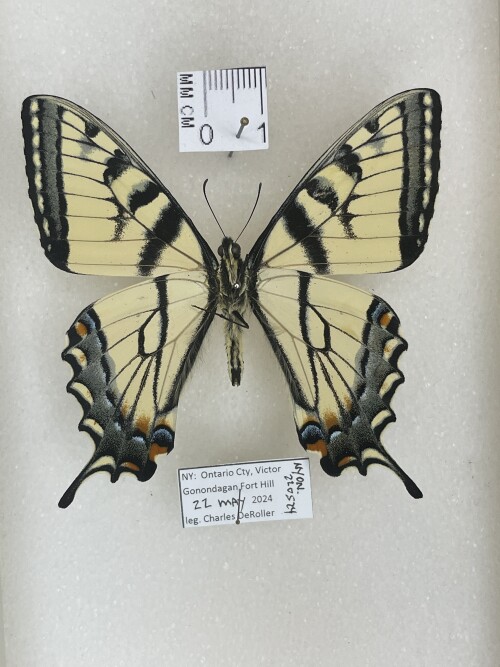
Female
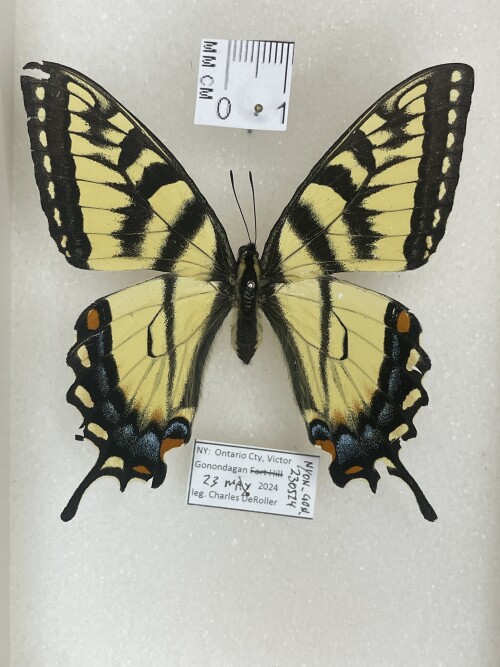

Some might say it looks like any old Tiger Swallowtail, which is of course not the case. Comparisons:
Larger than canadensis; smaller that nominate glaucus; about the size of small MST.
Wings more apexed than canadensis; HW not as elongated as MST. In this particular female, the wings are indeed apexed like MST.
Head tuft of hair between antennae like canadensis, but the black HW line alongside the abdomen isn't wide enough for canadensis; it is about the same as some MST.
FW verso submarginal yellow band unbroken or almost, like MST. HW verso black line separating yellow from dark is almost straight, more like canadensis and certainly like MST.
Yellow/ orange Lunules on HW verso are more square than glaucus, not close to canadensis, and not dissimilar to the variation of MST (compare the female to the male.)
Legs have been frozen for genetic analysis. I think "Spring Form" at least our Spring Form is not glaucus. We shall see.
-
Chuck

- Premium Member - 2024

- Posts: 963
- Joined: Mon May 23, 2022 2:30 pm
Re: Unique papilio polyxenes
by Chuck » Tue May 28, 2024 1:52 pm
-
Chuck

- Premium Member - 2024

- Posts: 963
- Joined: Mon May 23, 2022 2:30 pm
Re: Tiger Swallowtails of NY: Finger Lakes, Part II
by Chuck » Tue May 28, 2024 12:21 pm
In "Butterflies of Viginia" 1953(?) Clark & Clark went off-topic and delved into many pages on forms and ranges and flight periods found throughout eastern North America. For the most part, there has been no significant effort to add to that study- most of what we know is by-product of specific study (e.g. the description of appalachiensis).
About Tigers in the Toronto area, both Wang and Schmidt have published papers that discuss the ranges of glaucus, canadensis, and MST, including maps. I've posted links in this thread somewhere in the past. They are, of course, not comprehensive, and the range of MST (at least) is fluid. But the Canadians do have a far better view of the range of the three taxa than can be found for NY or anywhere in NE USA.
So I'd urge everyone who's interested to offer observations of any sort concerning Tigers, and not just in the east, there are "issues" in the west, and in the US south.
.......................
25 May 2024 I went up near the Lake Ontario shoreline to search for small Tigers that I believe a hybrid between Spring Form and canadensis. Hiking through some real tough deciduous regrowth for hours I saw nothing. Only when I got back in the truck did I see one, flying high along the forest edge as they do. Then garbage weather came in, and continues through today 5/28.
Observed 1, captured 0.
-
eurytides

- Posts: 206
- Joined: Tue May 24, 2022 1:36 am
Re: Tiger Swallowtails of NY: Finger Lakes, Part II
by eurytides » Mon May 27, 2024 6:22 am
- Attachments
-
- IMG_9971.png (298 KiB) Viewed 341 times
-
lamprima2
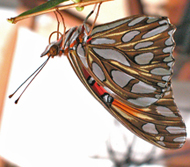
- Premium Member - 2024

- Posts: 107
- Joined: Mon May 23, 2022 8:16 pm
Re: "Proboscis case" in Sphingidae pupae (continuation)
by lamprima2 » Sun May 26, 2024 11:59 pm
-
mothman55
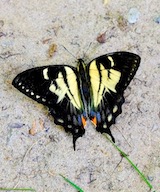
- Premium Member - 2024

- Posts: 111
- Joined: Mon May 23, 2022 12:09 pm
Re: Tiger Swallowtails of NY: Finger Lakes, Part II
by mothman55 » Sun May 26, 2024 10:45 pm
-
Trehopr1
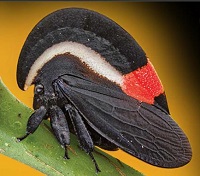
- Global Moderators

- Posts: 1018
- Joined: Thu Mar 31, 2022 1:48 am
Re: Tiger Swallowtails of NY: Finger Lakes, Part II
by Trehopr1 » Sun May 26, 2024 7:56 pm
I do hope you were able to catch that one before it flew away.....
-
Trehopr1

- Global Moderators

- Posts: 1018
- Joined: Thu Mar 31, 2022 1:48 am
Re: Unique papilio polyxenes
by Trehopr1 » Sun May 26, 2024 7:54 pm
I have never seen anything quite like that in all my life !
-
wollastoni

- Site Admin

- Posts: 483
- Joined: Fri Mar 18, 2022 9:51 am
Re: Love hairstreaks and blues
by wollastoni » Sun May 26, 2024 1:17 pm
-
wollastoni

- Site Admin

- Posts: 483
- Joined: Fri Mar 18, 2022 9:51 am
Re: "Proboscis case" in Sphingidae pupae (continuation)
by wollastoni » Sun May 26, 2024 1:14 pm
-
lamprima2

- Premium Member - 2024

- Posts: 107
- Joined: Mon May 23, 2022 8:16 pm
"Proboscis case" in Sphingidae pupae (continuation)
by lamprima2 » Sun May 26, 2024 4:09 am
structure and function of Sphinginae pupae's maxillary loops (aka "jug handle”). There was no reply. I contacted a few specialists in this area. One of them replied: "If you would look inside, you will see that the galeae extend from the head into the loop, then the galeae bend sharply back and turn back to the head of the pupae. On the pupae, you can see the distal part of the developing galeae in the midline of the pupae between the developing wings." I spent some time trying to find something illustrating this observation and finally found this amazing photograph by M. Albrecht (from Danner et al., “Die Schwarmer der westlichen Palearktis,” Herbipoliana, Band 4/2, 1998, Plate 46).
-
Boertje

- Posts: 2
- Joined: Sat May 25, 2024 2:57 am
Re: Can someone please identify regular housequest?
by Boertje » Sun May 26, 2024 3:40 am
Thank you very much for the extensive information. Much appreciated!
Best regards
B
